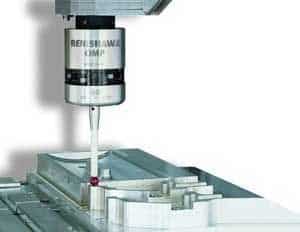CNCCookbook's G-Code Tutorial
What is the Purpose of Scaling, Anyway?
Scaling can be an extremely useful feature when creating a g-code program. For starters, you might have the same shaped feature and just need to repeat it in a different size. Scaling with G51 can make that easy. But, there's an even more clever use for scaling.

Let's say your machine is equipped with an accurate digital touch probe that can measure things very accurately. Let's further assume you need to make a bore that is extremely accurate and that your part is held in a fixture that has a bore right on the fixture that you have painstakingly made accurate to extreme tolerances. Lastly, let's say that bore has to be 2.000 inches, plus 0.0001 and minus 0.0000. That's pretty tight!
Now here is a neat trick you can perform with the probe:
- Measure the bore with the probe. You know it measures within your tolerances to 2 inches at the normal inspection temperatures your customer will use. Let's say the probe reports a measurement of 1.9993. The hole is allowed to be a tenth larger, but cannot be smaller than 2 inches. So you're off by 0.0007" and need the hole to be larger.
- So, your g-code performs a little calculation. 0.0007" / 2.0000" is 0.00035. Now you know the correction factor that's needed.
- When you make your finish pass, use G51 to scale the finish pass to 1.00035x the coordinates that are in the g-code program.
Your part should come out much closer than it would have without the feedback the probe supplies on how to correct for errors due to temperature changes and other factors. Very cool, eh?
That's the technique used in Renishaw's RAMTIC manufacturing, and it's a very powerful way to increase the accuracy of your machining operations.
G51: Apply the Same Scale Factor to All Axes
Scaling is pretty straightforward on Fanuc. The syntax for G51 looks like this:
G51 X_ Y_ Z_ P_
Where the XYZ words specify the absolute coordinates for the center of the scaling and P specifies the scaling factor or magnification to be applied. If XYZ are not specified, the coordinates of the current tool position are used.
G51: Apply a Different Scale Factor to Each Axis
In this version, you can scale all axes with a constant magnification, but Fanuc also allows you to scale with a different factor on each exis:
G51 X_ Y_ Z_ I_ J_ K_
In this case, the I-Word specifies magnification for the X-Axis, J for the Y, and K for the Z.
There are some neat tricks you can play when you can set the scaling independently for each axis. For example, set a negative value and you can create a mirror image.
Here's a sample program that uses G51 to mirror a figure 4 times that's created by a subprogram:
N10 G00 G90
N20 M98 P9000
N30 G51 X50 Y50 I-1000 J1000
N40 M98 P9000
N50 G51 X50 Y50 I-1000 J-1000
N60 M98 P9000
N70 G51 X50.0 Y50.0 I1000 J-1000
N80 M98 P9000
N90 G50
N100 M30
O9000
G00 G90 X60 Y60
G01 X100.0 F100
G01 Y100.0
G01 X60.0 Y60.0
M99
And here's a backplot in G-Wizard Editor showing what the resulting toolpath looks like:
Scaling, Arcs, and Circular Interpolation
I'm sure some of you immediately wondered if you could create ellipses by applying a scale factor to just one axis of an arc or circle move. The answer is, "No", you won't get any ellipses out of these controls.
Canceling Scaling
You use the G50 command to cancel scaling when you're done with it.
Try the Free Trial Version of G-Wizard CNC Program Editor...
No credit card required-just your name and email.
Next Article: Rotating the Coordinate System with G68 and G69
Be the first to know about updates at CNC Cookbook
Join our newsletter to get updates on what's next at CNC Cookbook.
